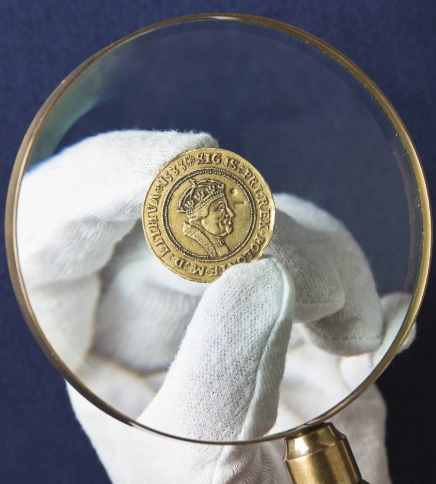The Hutten-Czapski Museum
ul. Piłsudskiego 12, 31-109 Kraków- Monday: closed
- tue : 10.00-18.00
- wednesday-sunday: 10.00-16.00
Information and reservations on weekdays 9 a.m.- 4 p.m.
The Director of the National Museum in Krakow
Deputy Director for Programme Activity
Deputy Director for Strategy and Communications
Deputy director for the Management
Chief Accountant
Chief Cataloguer of the National Museum in Krakow
Chief Conservator

Counterfeiting coins is as old as the coins themselves. Since the beginning, people tried to improve their economic existence by making their own money, infringing the rights of their official issuers.
This dirty practice did not stop despite severe punishments for forgers, among them sophisticated tortures aimed at discouraging coiners. Counterfeiting coins has always been considered one of the serious crimes, as it was aimed against the ruler, state and its citizens. Representatives of all social spheres were involved, not only those coming from a criminal background, but also princes, clergymen, bankers, the middle class, merchants and desperate paupers. Also, rulers themselves often used forged money as a weapon against their enemies. Initially, coin and note forgeries were detrimental only to the issuer, but soon they were joined by collectors. As collecting numismatic products became more and more popular, their prices increased and so did the number of forgeries. With the development of knowledge, methods of counterfeiting coins and notes have been further improved. An increasingly popular method is die-casting – the coin produced in such a way looks as if it had been hammered. 3D scanning allows making perfect templates, and artificial patination is developing. Minting modern equivalents is sometimes also done with original, but smooth antique coins, which makes it impossible to detect the forgery by means of metal composition analysis. Counterfeit has been made even easier since transactions are made on the Internet, where authenticity is mostly verified on the basis of pictures. Even serious auction houses and companies dealing with verifying coin authenticity sometimes have problems with modern forgeries.
False money is still with us today, although sometimes we are unaware of having it and then when we use it to pay, we distribute it, without even knowing. Similar is the case with forging historic coins. Who would not be tempted to buy a handful of ancient coins during exotic holidays, dug out “just a minute before” from the desert sand and offered by their founder at the gate of a resort, or at the foot of a tourist attraction. We are happy to buy such an exquisite souvenir, hoping to sell it with profit. We are unaware that dozens of forgers’ workshops, or even small factories, work at full speed in Europe or China to produce kilograms of false money.
In the collection of numismatic products kept at the Emeryk Hutten-Czapski Museum, among exquisite items hammered in precious metals, numerous unique objects, and rarities, there are also some objects representing a dark side of coinage and collecting. A lot of them are ugly, badly made and devoid of the spirit of the era.
False coins have entered the Numismatic Room at the National Museum in Krakow in different ways. Forgeries done in old times were present in collections given to the Museum, such as the collection of Emeryk Hutten-Czapski (1828–1896), or Zygmunt Zakrzewski (1867–1951) and they were consciously included by their creators, according to the recommendation of a great numismatist Karol Beyer, to let a collection show also the dark side of numismatics. There were also forgeries detrimental to collectors, discovered in the nineteenth century, but left as a curiosity or a warning for new generations of collectors. Whereas unrecognized fakes were kept in the collection for years, to finally be discovered thanks to inquisitive researchers. Currently, the collection of false coins of the Numismatic Room, whose core is the gift from Lech Kokociński (4,500 items), consists of nearly 7 thousand objects and is still growing. The exhibition will feature a selection of items from this collection, from antiquity to 1990, including those created to the detriment of the issuer and collectors.
Curators: Anna Bochnak, Mateusz Woźniak
